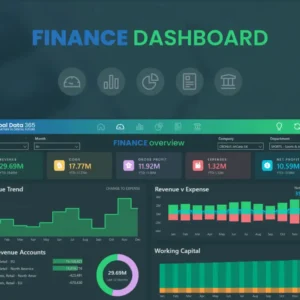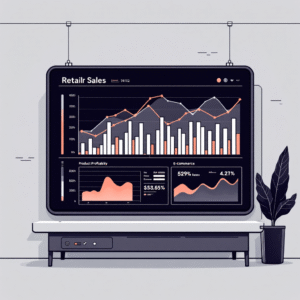Power BI for SaaS Companies: MRR, ARR, and Churn Dashboards
Master subscription metrics with professional Power BI dashboards
In today's competitive SaaS landscape, having clear visibility into your Monthly Recurring Revenue (MRR), Annual Recurring Revenue (ARR), and churn rates isn't just beneficial—it's essential for survival. Power BI emerges as the ultimate solution for SaaS companies seeking to transform complex subscription data into actionable insights that drive growth and reduce customer attrition.
SaaS businesses operate on unique financial models that traditional accounting reports simply can't capture effectively. Unlike one-time sales, subscription-based revenue requires sophisticated tracking of customer lifecycle metrics, expansion revenue, and predictive analytics. Power BI's robust capabilities enable SaaS companies to build comprehensive dashboards that not only monitor current performance but also forecast future trends and identify potential risks before they impact the bottom line.
The power of visualizing SaaS metrics through Power BI lies in its ability to connect disparate data sources—from CRM systems like Salesforce to billing platforms such as Stripe or Chargebee—creating a unified view of your subscription business. This integration eliminates data silos and provides stakeholders with real-time insights that are crucial for making informed strategic decisions in the fast-paced SaaS environment.
Ready to Transform Your SaaS Analytics?
Get expert guidance on building professional Power BI dashboards for your SaaS metrics. Our team specializes in MRR, ARR, and churn analysis dashboards.
Understanding SaaS Key Performance Indicators
Before diving into Power BI dashboard creation, it's crucial to understand the fundamental SaaS metrics that will drive your analytics strategy. These metrics form the backbone of any successful SaaS business intelligence implementation.
Essential SaaS Metrics Overview
Monthly Recurring Revenue (MRR): The Heartbeat of SaaS
MRR represents the predictable revenue your SaaS business generates each month from subscription fees. This metric is fundamental because it provides a normalized view of your revenue stream, accounting for different subscription plans, upgrades, downgrades, and new acquisitions. Understanding MRR trends helps predict cash flow and evaluate business growth trajectory with remarkable accuracy.
Power BI excels at breaking down MRR into its component parts: New MRR from acquired customers, Expansion MRR from upgrades, Contraction MRR from downgrades, and Churned MRR from canceled subscriptions. This granular view enables SaaS leaders to identify which customer segments and product tiers drive the most sustainable growth.
| MRR Component | Description | Power BI Calculation | Business Impact |
|---|---|---|---|
| New MRR | Revenue from new customers | SUM(New Customer Revenue) | Measures acquisition success |
| Expansion MRR | Additional revenue from existing customers | SUM(Upgrade Revenue) | Indicates product value realization |
| Contraction MRR | Revenue lost from downgrades | SUM(Downgrade Revenue) | Signals potential churn risk |
| Churned MRR | Revenue lost from cancellations | SUM(Canceled Customer Revenue) | Direct revenue impact measurement |
Annual Recurring Revenue (ARR): The Strategic North Star
While MRR provides monthly insights, ARR offers a strategic perspective on your SaaS business's long-term trajectory. ARR is particularly valuable for enterprise SaaS companies with annual contracts and is essential for investment discussions, strategic planning, and valuation purposes. Power BI dashboards can display ARR trends alongside leading indicators that predict future ARR performance.
The relationship between ARR and MRR isn't always straightforward due to annual discounts, seasonal variations, and varying contract terms. Power BI's advanced DAX calculations enable accurate ARR computation that accounts for these complexities, providing stakeholders with reliable annual projections based on current subscription data.
Churn Analysis: The Silent Revenue Killer
Customer churn represents the percentage of customers who discontinue their subscription during a specific period. For SaaS businesses, churn analysis is critical because acquiring new customers typically costs 5-25 times more than retaining existing ones. Power BI's analytical capabilities enable sophisticated churn prediction models that help identify at-risk customers before they cancel.
Advanced Churn Metrics in Power BI
- Logo Churn: Percentage of customers who canceled
- Revenue Churn: Percentage of revenue lost from cancellations
- Net Revenue Churn: Revenue churn minus expansion revenue
- Cohort-based Churn: Churn analysis by customer acquisition period
- Predictive Churn Scoring: ML-powered risk assessment
Building Professional SaaS Dashboards in Power BI
Creating effective SaaS dashboards requires careful consideration of data architecture, visualization design, and user experience. The most successful Power BI implementations for SaaS companies follow a structured approach that balances comprehensive data coverage with intuitive navigation and actionable insights.
Data Integration and Modeling
The foundation of any powerful SaaS dashboard lies in robust data integration. Power BI's extensive connector library enables seamless integration with popular SaaS tools including Salesforce, HubSpot, Stripe, Chargebee, and custom APIs. The key to successful integration is establishing a consistent data model that accurately reflects your subscription business logic.
Your Power BI data model should include dimension tables for customers, products, and time periods, along with fact tables for transactions, subscriptions, and usage events. This star schema approach optimizes query performance while maintaining flexibility for complex SaaS calculations. Implementing proper data governance ensures consistency across different dashboard views and prevents conflicting metric interpretations.
| Data Source | Key Tables | Primary Metrics | Refresh Frequency |
|---|---|---|---|
| Billing System | Subscriptions, Invoices, Payments | MRR, ARR, Payment Status | Daily |
| CRM Platform | Accounts, Contacts, Opportunities | Customer Segments, Sales Pipeline | Hourly |
| Product Analytics | User Events, Feature Usage | Engagement Scores, Adoption Rates | Real-time |
| Support System | Tickets, Satisfaction Surveys | Health Scores, NPS | Daily |
Dashboard Design Principles for SaaS Metrics
Effective SaaS dashboard design prioritizes clarity and actionability over visual complexity. The most successful dashboards follow a hierarchical information architecture: executive summaries at the top level, operational metrics in the middle, and detailed drill-down capabilities at the granular level. This approach ensures that different stakeholders—from CEOs to customer success managers—can quickly access relevant insights without information overload.
Color coding plays a crucial role in SaaS dashboard effectiveness. Establish consistent color schemes where green indicates positive trends (growth, retention), red signals concerns (churn, downgrade risks), and neutral colors present baseline metrics. Power BI's conditional formatting capabilities enable dynamic color changes based on performance thresholds, making exceptions immediately visible.
Advanced DAX Calculations for SaaS Metrics
Power BI's DAX (Data Analysis Expressions) language enables sophisticated calculations that accurately represent SaaS business logic. These calculations must account for the complexities of subscription models, including prorated billing, plan changes, and seasonal adjustments.
Implementing time intelligence functions in DAX allows for period-over-period comparisons that are essential for trend analysis. Year-over-year growth rates, month-over-month changes, and rolling averages provide context that helps stakeholders understand whether current performance represents temporary fluctuations or meaningful trends.
Implementing Churn Prediction Models
Advanced Power BI implementations can incorporate machine learning models that predict customer churn probability based on historical patterns and behavioral indicators. These predictive models analyze factors such as usage frequency, support ticket volume, payment delays, and engagement scores to identify customers at risk of cancellation.
Integration with Azure Machine Learning enables sophisticated churn prediction algorithms that continuously improve accuracy as more data becomes available. These models can trigger automated alerts when customers exceed predetermined risk thresholds, enabling proactive intervention by customer success teams.
Transform Your SaaS Analytics Today
Don't let poor visibility into your subscription metrics limit your growth potential. Our Power BI experts specialize in creating custom SaaS dashboards that drive results.
Best Practices for SaaS Power BI Implementation
Performance Optimization Strategies
SaaS datasets often contain millions of subscription events and customer interactions, making performance optimization critical for dashboard usability. Implementing proper indexing strategies, data compression techniques, and incremental refresh policies ensures that dashboards load quickly even with extensive historical data.
DirectQuery and Import mode selection significantly impacts dashboard performance. For real-time metrics like current MRR, DirectQuery provides up-to-the-minute accuracy, while historical trend analysis performs better with imported data. Hybrid models that combine both approaches optimize performance while maintaining data freshness where needed.
Security and Governance Considerations
SaaS companies handle sensitive customer and financial data, making security a paramount concern in Power BI implementation. Row-level security (RLS) ensures that sales representatives see only their territory's data, while customer success managers access information for their assigned accounts. Dynamic security models based on Azure Active Directory groups streamline user management while maintaining strict access controls.
Data governance frameworks should establish clear definitions for each metric, ensuring consistent interpretation across different teams and time periods. Documentation of calculation logic, data sources, and refresh schedules prevents misunderstandings that could lead to incorrect business decisions.
Mobile Optimization for SaaS Dashboards
SaaS leaders need access to critical metrics regardless of location, making mobile optimization essential. Power BI's mobile app provides native support for SaaS dashboards, but effective mobile design requires careful consideration of screen real estate and touch navigation. Key metrics should be prominently displayed, while detailed analyses remain accessible through intuitive drill-down interfaces.
Measuring Success and ROI
The ultimate measure of Power BI implementation success in SaaS companies is improved business outcomes rather than technical metrics. Successful implementations typically demonstrate measurable improvements in customer lifetime value, reduced churn rates, and faster identification of growth opportunities. These business impacts justify the investment in professional Power BI development and ongoing maintenance.
Regular dashboard usage analytics help identify which visualizations provide the most value and which features require enhancement. Power BI's built-in usage metrics reveal user engagement patterns that inform dashboard optimization strategies and ensure continued relevance as business needs evolve.
Continuous Improvement Framework
SaaS businesses evolve rapidly, requiring dashboard solutions that adapt to changing requirements. Establishing a continuous improvement framework ensures that Power BI implementations remain valuable as companies scale, enter new markets, or modify their product offerings. Regular stakeholder feedback sessions identify opportunities for enhancement and help prioritize development efforts.
Key Success Indicators for SaaS Power BI Dashboards
- Reduced time to identify churn risks from days to hours
- Improved forecast accuracy for MRR and ARR projections
- Enhanced customer segmentation capabilities
- Automated alert systems for metric anomalies
- Streamlined reporting processes for stakeholder communication
Future Trends in SaaS Analytics
The evolution of SaaS analytics continues to accelerate with advancing AI capabilities, real-time data processing, and predictive modeling technologies. Power BI's integration with Microsoft's AI ecosystem positions SaaS companies to leverage these innovations without extensive technical overhead.
Emerging trends include customer journey analytics that track subscription lifecycle stages, predictive pricing optimization models, and automated customer health scoring systems. These capabilities transform reactive business intelligence into proactive strategic tools that drive competitive advantage in crowded SaaS markets.
Integration with Modern Data Stack
Contemporary SaaS companies increasingly adopt cloud-native data architectures that emphasize real-time processing and automated data pipelines. Power BI's compatibility with Azure Data Factory, Synapse Analytics, and other Microsoft data services enables seamless integration with modern data stacks while maintaining the familiar interface that business users prefer.
The convergence of business intelligence and operational systems creates opportunities for closed-loop analytics where dashboard insights automatically trigger business process improvements. This integration transforms Power BI from a reporting tool into a central component of automated business optimization systems.
Conclusion
Power BI represents the optimal solution for SaaS companies seeking comprehensive visibility into their subscription metrics. The platform's combination of robust data integration capabilities, sophisticated analytical functions, and intuitive visualization tools enables organizations to transform complex subscription data into actionable business insights.
Success with Power BI in the SaaS context requires more than technical implementation—it demands deep understanding of subscription business models, careful attention to data quality and governance, and commitment to continuous improvement based on stakeholder feedback. Organizations that invest in professional Power BI development and maintain focus on business outcomes realize significant returns through improved customer retention, optimized pricing strategies, and enhanced strategic decision-making capabilities.
The journey from basic reporting to advanced SaaS analytics represents a transformative opportunity for subscription businesses. With proper planning, skilled implementation, and ongoing optimization, Power BI dashboards become indispensable tools that drive sustainable growth and competitive advantage in the dynamic SaaS marketplace.
Related Resources
PowerBIGate Homepage - Explore our complete range of Power BI services and solutions Essential Financial KPIs Every Power BI Dashboard Should Track - Master financial reporting with comprehensive KPI guidance How to Build a CFO Executive Dashboard in Power BI - Create executive-level financial dashboards with our free templateReady to Optimize Your SaaS Metrics?
Partner with PowerBIGate's expert team to build world-class Power BI dashboards that transform your SaaS analytics. Get started with a free consultation today.







